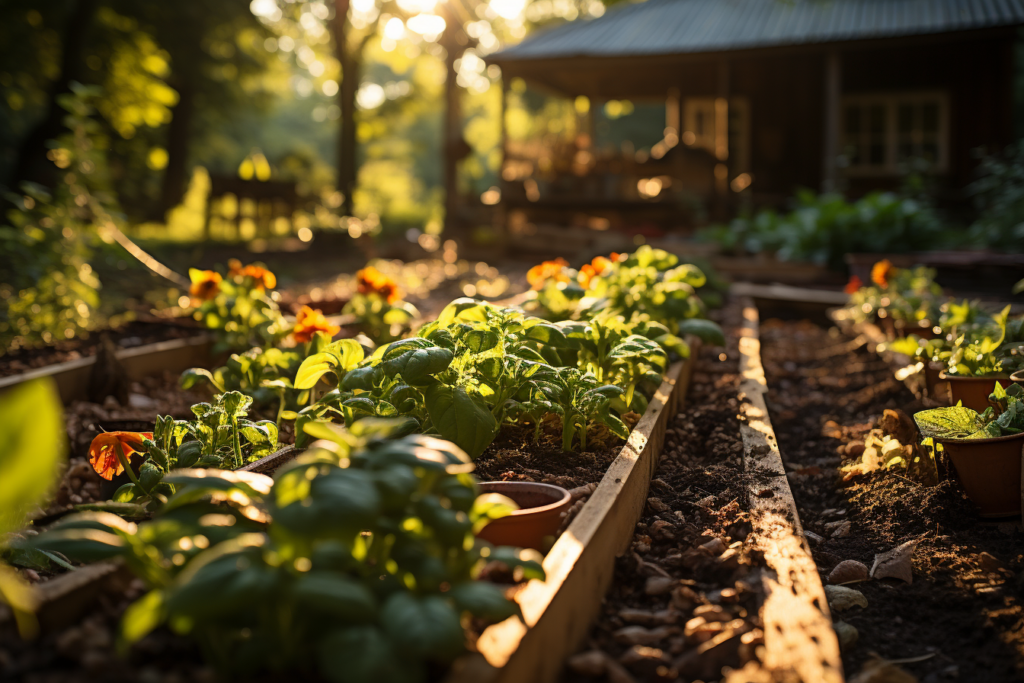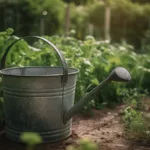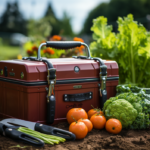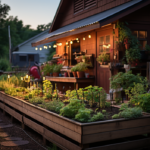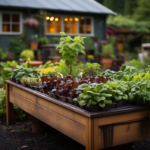Table of Contents
Transform Your Community and Promote Sustainable Living Through Community Gardening: Here’s How to Get Started
Are you looking for a fun and meaningful way to bring your neighbors together while promoting sustainable living? Starting a community garden in your neighborhood may just be the perfect solution! Community gardens not only provide a place for locals to grow fresh fruits and vegetables, but also create an opportunity for community members to connect and work towards a common goal. They are also great for promoting outdoor activity and helping people develop a deeper appreciation for the natural world. In this article, we’ll explore the essential steps to creating your own community garden and offer tips on how to make it a success. Let’s get started!
Planning Your Garden: Choosing a Site, Designing the Layout, and Getting Supplies
Starting a community garden in your neighborhood can require some planning, but the process can also be fun and rewarding. Here are some essential aspects to keep in mind when planning your community garden:
Choosing a Site
Choosing the right site is crucial to the success of your community garden. Here are some things to consider when selecting a location:
- Look for a sunny location: To maximize plant growth, your garden should have access to at least six hours of direct sunlight each day.
- Consider access to water: Ensure that your garden is near a water source, such as a faucet or hose, to make watering your plants more convenient.
- Think about the soil: Look for soil that is fertile and well-drained. If the soil is compacted or lacks nutrients, it might be necessary to amend it with compost or other organic materials.
Designing the Layout
Designing the layout of your community garden can help ensure that it is both functional and aesthetically pleasing. Here are some things to consider when designing your garden:
- Plan for paths: It’s important to have pathways that are wide enough to allow for easy maintenance and access to all areas of the garden.
- Consider raised garden beds: Raised garden beds can help prevent soil erosion and make gardening more accessible for people with disabilities.
- Think about the placement of crops: Consider the amount of space each crop will need and group similar plants together to simplify maintenance tasks.
Getting Supplies
Once you have chosen a site and designed the layout of your garden, it’s time to gather the necessary supplies. Here are some essential items that you’ll need:
- Garden tools: These include items like shovels, hoes, and rakes.
- Seeds or plants: Consider what you want to grow in your garden and purchase seeds or plants accordingly.
- Soil amendments: These can include things like compost, fertilizers, and mulch.
- Garden hoses or watering cans: Ensure that you have a way to water your plants.
In conclusion, choosing the right site, designing the layout, and getting the supplies are all essential aspects of starting a successful community garden. With careful planning and preparation, you can create a thriving garden that brings your community together and promotes healthy living.
Tips for Growing a Thriving Garden: Soil Preparation, Planting and Maintaining Crops
Once you have planned and established your community garden, the next step is to ensure its long-term success. Here are some tips for growing and maintaining a thriving garden that will yield healthy and bountiful crops for years to come.
Prepare Your Soil
- The soil provides the foundation for your garden. Ensure it is healthy and fertile by testing it for nutrient content and pH levels.
- Amend the soil as necessary to optimize the pH level and nutrient content. You can add compost, manure, or fertilizer to enrich the soil.
- Use raised beds to improve drainage, especially if the soil is clay-heavy.
Choose Your Plants Carefully
- Consider the climate, soil type, and sun exposure of your garden when choosing crops.
- Opt for plants that thrive in your region, and are resistant to local pests and diseases.
- Mix perennials, annuals, vegetables, and plants that flower, as they tend to support one another by providing nutrients and pollination.
Plant Your Crops
- Transplant seedlings or start from seeds in the right season and time of day. This varies per crop, and local gardening stores or online resources can help you determine the right time.
- Give your plants enough space to grow, and keep in mind that some plants need more sun exposure than others.
- Water your plants regularly, either manually or by installing an irrigation system.
Maintain Your Garden
- Pull weeds regularly to reduce competition for water and nutrients.
- Control pests and diseases through natural means, and avoid using chemical pesticides.
- Harvest crops at peak ripeness to maximize yield.
By following these tips, your community garden will be well-equipped to grow a variety of healthy crops year-round. Make sure to document and share your garden’s progress with the community using social media, newsletters, and community events to encourage engagement and support from fellow gardeners.
Getting Your Community Involved: Outreach Strategies, Recruitment, and Organizing Volunteers
Creating a community garden can be an effective way to bring people together and promote sustainable living. However, building a community garden requires more than just physical labor – it requires the support and enthusiasm of the entire community. In this section, we’ll discuss some essential aspects to get your community involved in your community garden project.
Outreach Strategies
Before you start building your community garden, you’ll need to get the word out. Here are some effective outreach strategies to share your idea with your community:
- Flyer Distribution: Creating and distributing flyers is one of the easiest and most cost-effective ways to spread the word about your community garden project. You can post flyers on community bulletin boards or places like community centers, libraries, or coffee shops.
- Social Media: Social media platforms like Facebook, Twitter, and Instagram can be excellent platforms to connect with people interested in community gardening. Use social media to share information, create awareness, and update followers on progress.
- Newsletters: You can create a newsletter to share information and updates about your community garden project. Use newsletters to keep your community informed about upcoming events, meetings and to celebrate milestones.
Recruitment
Once you have introduced the concept of a community garden, it’s time to start recruiting participants. Here are some strategies for recruiting members:
- Engage Schools: Engage schools, scout groups, and church groups in your community. By recruiting children, you are building future generations of gardeners, and their energy can be very infectious.
- Local Outreach: Consider reaching out to neighborhood associations, cultural centers, or conservation organizations, or local business owners and advertise your garden project.
- Create Collaborations: Get businesses or individuals to sponsor your garden or donate seeding materials, gardening tools, or money.
Organizing Volunteers
Now that you have established a good number of interested participants, it’s time to move forward to the organizational phase of your community garden. Here are some tips for organizing your team:
- Assign Roles: Enlist volunteers to help with tasks such as site design and soil preparation, fundraising, and recruitment. Give specific positions and volunteer responsibilities to each team member.
- Hold Regular Meetings: Schedule regular meetings, so everyone has the chance to share ideas, address problems, and offer feedback.
- Celebrate: Your volunteers are likely donating their time and energy, make time to recognize and appreciate them. Celebrate their contributions and hard work by hosting special events, and creating opportunities for them to socialize.
Getting your community involved in your community garden project may seem daunting, but with these tips, it can be quite simple. Remember, community gardens are more than just places to grow food – they are places for learning, building friendships, and strengthening community connections. Stay tuned for more insights in our next segment as we explore maintaining your garden.
Promoting Sustainability and Success: Building Community, Managing Resources, and Managing Challenges
Starting a community garden in your neighborhood can be a great way to promote more sustainable living and foster a sense of community among your neighbors. However, the success of your garden will depend on more than just finding the right location and planting the right crops. Here are some important factors to consider when aiming for a successful and sustainable community garden:
Building Community
One of the keys to success for any community project is building a strong sense of community among the participants. Here are some strategies for building a strong sense of community in your neighborhood garden:
- Host regular community events: Events like potlucks, garden tours, and workshops can be a great way to bring garden members together and build relationships.
- Collaborate with local organizations: Partnering with local organizations such as schools, community centers, or churches can help connect your garden to a wider audience and give you access to additional resources and support.
- Foster communication: Use social media or email chains to keep everyone informed about upcoming events or work days. Encourage open communication and transparency among garden members to help build trust and accountability.
Managing Resources
Managing resources effectively is also key to ensuring the longevity and success of your community garden. Here are some tips to help you manage resources effectively:
- Use sustainable practices: Use organic gardening practices, composting methods, and other sustainable techniques to help reduce waste and promote the long-term health of your garden.
- Use a shared resource system: Create a shared tool library and develop a system for sharing resources like water and mulch to help reduce waste and ensure that everyone has access to the resources they need.
Managing Challenges
Building a thriving community garden can also involve managing potential challenges such as pest infestations, drought, or garden theft. Here are some tips for managing potential challenges:
- Plan for contingencies: Develop a contingency plan for potential challenges like bad weather, pest infestations, or theft. Having a plan in place can help you respond quickly and mitigate potential losses.
- Use collaborative problem-solving: Encourage all members of the garden to be involved in problem-solving discussions. This can help build trust and ensure that everyone’s concerns are heard.
- Encourage flexibility and creativity: Encourage members of the garden to be creative and adaptable in their approaches to challenges. This can help promote innovation and ensure that the garden thrives in the long-term.
By building community, managing resources, and being prepared for challenges, your community garden can be a sustainable and successful community project that brings lasting benefits to your neighborhood.
Conclusion
Starting a community garden in your neighborhood is a great way to bring people together and promote sustainability. It provides a space where people can connect, work towards something meaningful, and improve their local environment. By following the essential steps, such as choosing the right site, designing the layout, recruiting volunteers, and managing resources, you can create a thriving community garden. Just remember, the success of your garden will depend on the commitment and enthusiasm of the volunteers involved, so make sure to foster a sense of community and encourage everyone to get involved. With a little hard work and dedication, your community garden can become a hub for local food, people, and nature.

